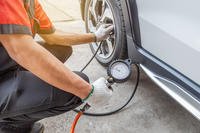There are many of reasons why you should put a down payment on a car purchase. Yes, there are tons of people out there who will loan you the whole value of the car, but that is (almost always) a bad idea. A friend's recent situation reminded me of this fact when her car was totaled in an accident. She needed to replace it, but she was underwater on her car loan because she hadn't contributed any money toward the purchase and had financed the whole cost. Fortunately, I think, she had GAP insurance on her loan, so at least the balance of her loan will be paid off and she won't owe thousands of dollars for a wrecked vehicle. On the other hand, she now has no down payment for this new car, which means that she'll probably purchase the GAP insurance again, costing between $400 and $600, and if a similar situation occurs again, she'll be back to zero for a third time in this cycle.
Transportation costs are typically the second or third largest expenses in a family's budget (with housing and food taking the other two top positions.) The purchase of a new, or new-to-you, vehicle is an excellent opportunity to reset your family's transportation expenses. Unfortunately, cars are expensive. An average cost of a new car in 2015 exceeded $30,000. A five year loan on a $30,000 car will cost you $500 a month even if you get a 0% interest promotional offer. $500 a month...that's a lot of money, and seems like even more since the recent report that almost half of Americans could not scrounge up $400 to deal with an emergency. If you can't find $400 for an emergency, then where are you going to find $500 every single month for a car payment?
This is where the down payment comes into the equation. If you can put just $2,500 down on your car purchase, you can shorten your loan by 5+ months with the same payment, or get a payment that is $42 less each month for the same term. The larger the down payment, the larger the savings.
More importantly, once you hit 20%, there is no reason for that expensive GAP insurance, and you've greatly increased the chances that you'll have value in your vehicle if another accident occurs. That little down payment is the first step in breaking the cycle of expensive car payments forever.
Unfortunately, if $400 is a problem for many Americans, then a $2,500 down payment is overwhelming for most. What are some other solutions? You can buy a pre-owned vehicle, which will have a significantly flatter depreciation curve and a lower chance that you'll owe more than the car is worth if it needs to be replaced. You can also choose to purchase a less expensive car...it doesn't change the depreciation curve, but if you select a shorter term, you'll pay down the loan faster and boost the odds that you won't be underwater
If you are in a situation where you want or need to purchase a car, please try to find a way to make a down payment. If that's not possible, consider other ways to minimize the amount that you're borrowing or shorten your loan term. Eventually, you can get out of the car payment business altogether. How great would that be?
Full disclosure: I've financed entire car purchases FIVE times in my life. Only the first one was a complete mistake, and I was lucky and didn't wreck the car until two months before it was paid off. The next three times, I had savings but was able to obtain promotional financing at great rates. The last time, I actually had the entire purchase price in my savings account, but we were embarking on a weird, overseas move and I was reluctant to spend that much savings while we were entering into a period of financial uncertainty. Once we got settled, we paid off the loan quickly. Hopefully, those of you who have savings and are financially savvy understand that this post isn't directed at your decisions!









